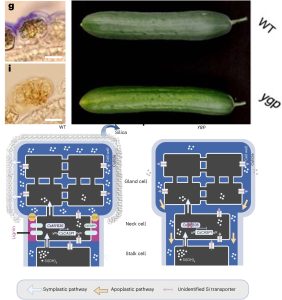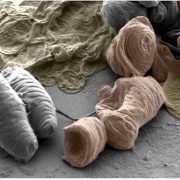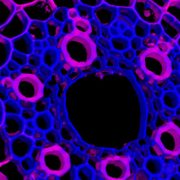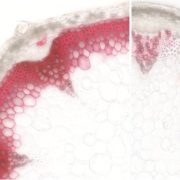Novel lignin-based extracellular barrier in glandular trichome
 This is a fascinating story by Hao et al., which takes us from phenotype to novel insights by looking at glandular trichomes in cucumber. Cucumber fruits often have a silica-based white powder deposited on their surface, but this is missing from the yellow green peel (ygp) mutant. Staining shows that the silica is deposited on the surface of glandular trichomes of wild-type plants but not on the mutants. The YGP gene encodes MYB36, which in Arabidopsis is a master regulator of Casparian strip formation. The Casparian strip is a lignin-based apoplastic barrier that controls apoplastic movement in the root endodermis. Transcriptomic analysis showed that in the ygp mutant one of the most down-regulated genes is CASP1, which is a direct target of MYB26 and in the endodermis is a scaffold protein for Casparian strip formation. The authors looked at the expression pattern of CASP1 in cucumber and found that it is highly expressed in the neck cells of glandular trichomes. Additional experiments showed that in the neck region, there is an apoplastic accumulation of lignin as has been observed in the Casparian strip. The authors propose a model in which there is an apoplastic barrier in the neck region of glandular trichomes that keeps the silica exudate on the surface of these cells, but in the ypg mutant is missing, allowing this exudate to move apoplasticaly away from the surface. Finally, they identified similar structures of glandular trichomes of several other species. Given the usefulness of several compounds produced by glandular trichomes, it will be interesting to see if these new insights can be applied commercially. (Summary by Mary Williams @PlantTeaching) Nature Plants 10.1038/s41477-024-01626-x
This is a fascinating story by Hao et al., which takes us from phenotype to novel insights by looking at glandular trichomes in cucumber. Cucumber fruits often have a silica-based white powder deposited on their surface, but this is missing from the yellow green peel (ygp) mutant. Staining shows that the silica is deposited on the surface of glandular trichomes of wild-type plants but not on the mutants. The YGP gene encodes MYB36, which in Arabidopsis is a master regulator of Casparian strip formation. The Casparian strip is a lignin-based apoplastic barrier that controls apoplastic movement in the root endodermis. Transcriptomic analysis showed that in the ygp mutant one of the most down-regulated genes is CASP1, which is a direct target of MYB26 and in the endodermis is a scaffold protein for Casparian strip formation. The authors looked at the expression pattern of CASP1 in cucumber and found that it is highly expressed in the neck cells of glandular trichomes. Additional experiments showed that in the neck region, there is an apoplastic accumulation of lignin as has been observed in the Casparian strip. The authors propose a model in which there is an apoplastic barrier in the neck region of glandular trichomes that keeps the silica exudate on the surface of these cells, but in the ypg mutant is missing, allowing this exudate to move apoplasticaly away from the surface. Finally, they identified similar structures of glandular trichomes of several other species. Given the usefulness of several compounds produced by glandular trichomes, it will be interesting to see if these new insights can be applied commercially. (Summary by Mary Williams @PlantTeaching) Nature Plants 10.1038/s41477-024-01626-x









